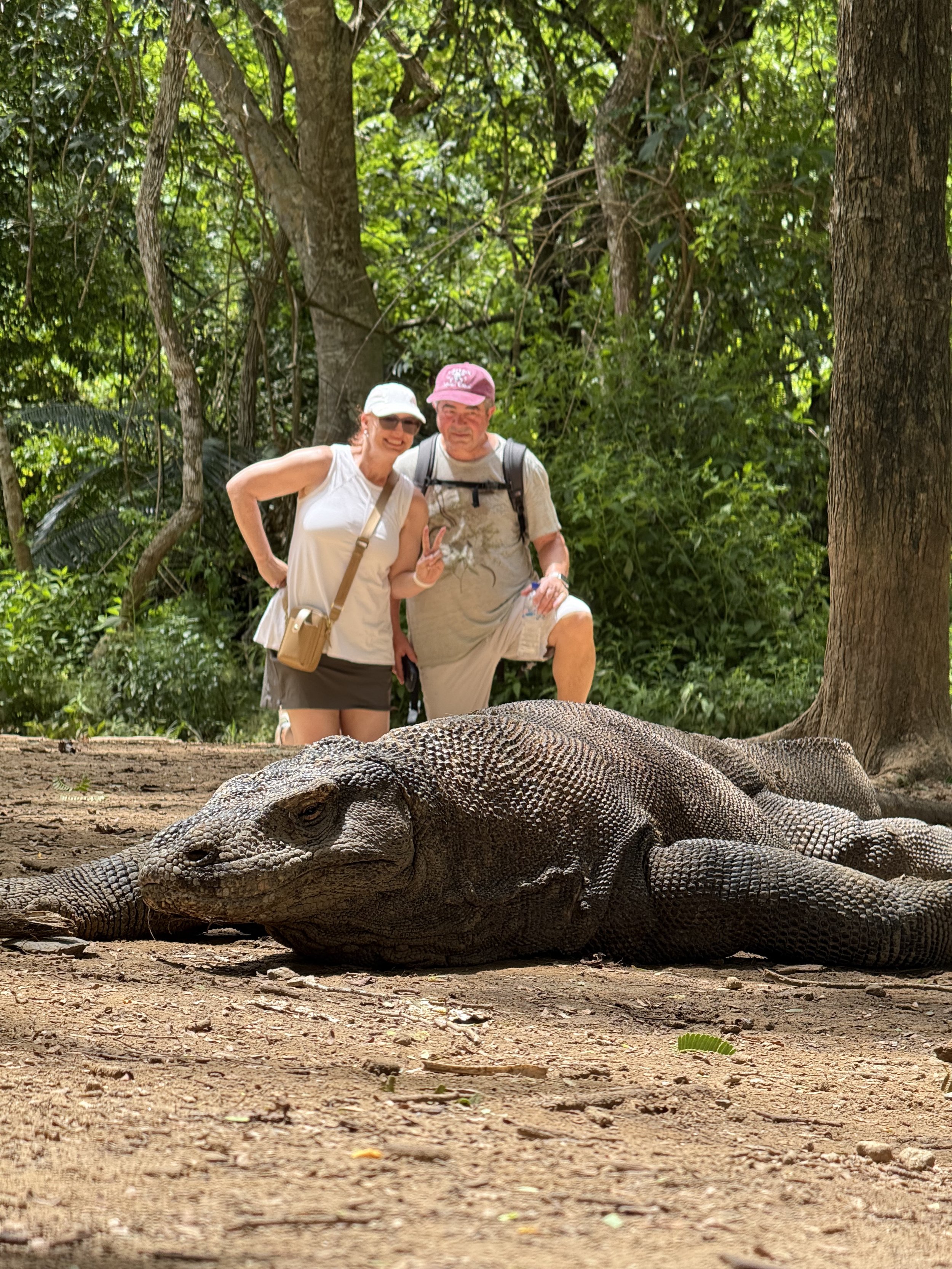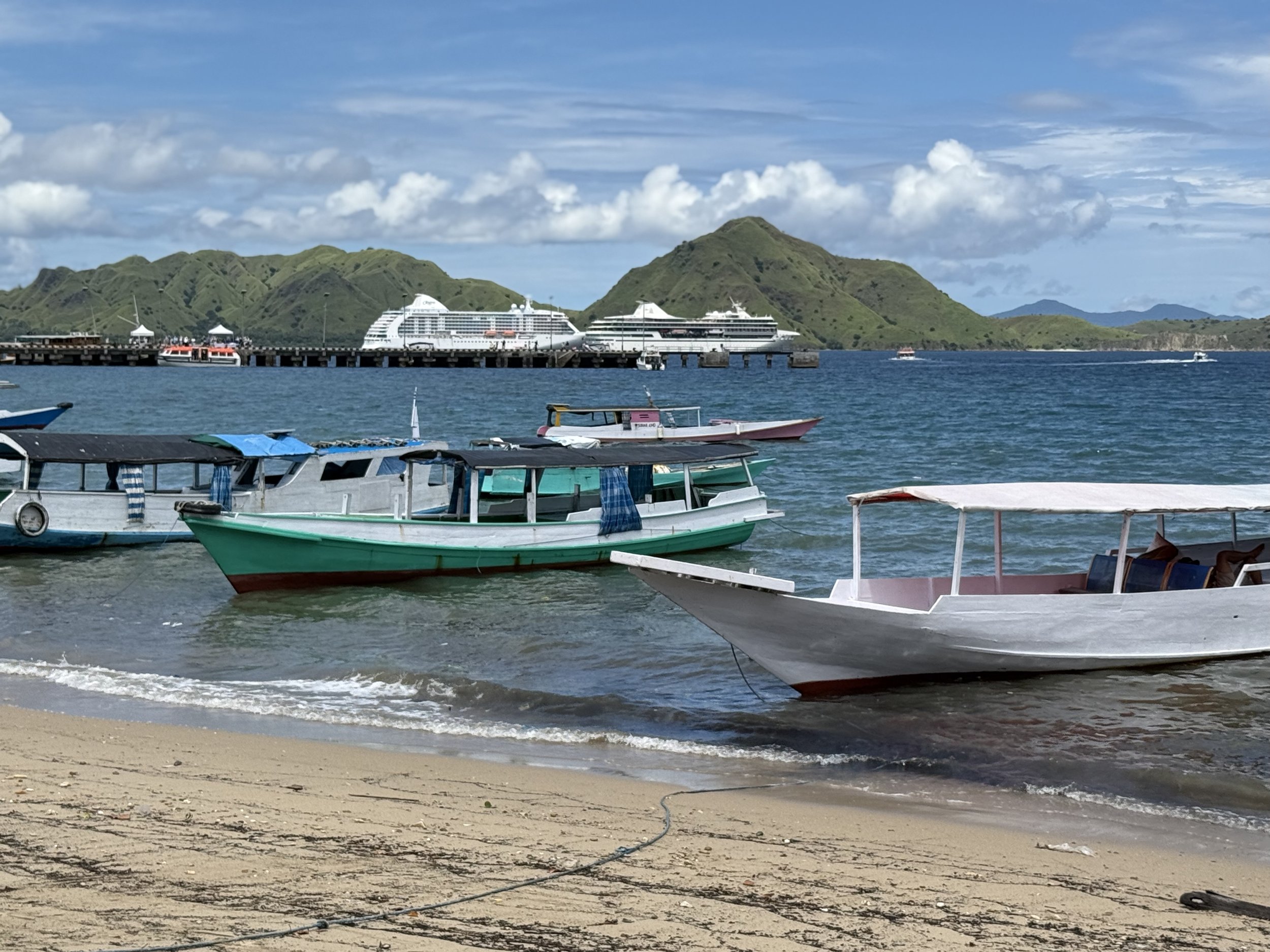Thar Be Dragons: Our Wild Day at Komodo Island
If you’ve ever wanted to feel like you're walking through a National Geographic special—or straight into a scene from Jurassic Park—then let us introduce you to Komodo Island.
We arrived via tender boat from our cruise ship, which was conveniently anchored just off the island. The ride over was short, sweet, and scenic—just enough time to mentally prepare ourselves for what was about to be a very reptilian adventure.
Komodo Island is part of the Komodo National Park in Indonesia, a UNESCO World Heritage Site known for being home to actual dragons. Okay, not fire-breathing ones, but still—the Komodo Dragon is the largest living lizard on Earth. These guys can grow up to 10 feet long and weigh over 300 pounds, and they’re not just big... they’re apex predators. Basically, they eat whatever they want—including (gulp) people. No pressure.
Upon arrival, we were split into groups of 24 and paired with three guides, which felt both official and... slightly ominous. One guide led the way, one brought up the rear, and the third floated around the group, scanning the trees like someone who’s seen too many horror movies.
The hour-long forest trek took us through dense, dry tropical woodland—Komodo’s unique savanna-meets-coastal-forest terrain. Along the way, our guides pointed out local trees and explained how this remote island chain supports such a unique ecosystem. Turns out, Komodo Dragons live a pretty chill life: they eat about once a month (a whole deer or buffalo, bones and all), then laze around digesting like ancient, scaly royalty.
We didn’t have to wait long before we saw our first dragons—three of them! Just sprawled out in a clearing like oversized sunbathing sausages. They looked peaceful… but also like they could wreck your whole day if they felt like it. Thankfully, they were full (we hoped), and we got to snap a few close-ish photos while trying not to breathe through our noses. Fun fact: dragons are cool, but they smell terrible—like horse stables and something you’d rather not step in.
After that thrilling encounter, we continued through the forest (now fully convinced every stick and log was a camouflaged lizard) and eventually made our way back to the beach. Surprise! More dragons—just casually hanging out in the sand, perfectly blending in with their surroundings. Honestly, they were so stealthy it made us think twice about future beach strolls.
Our final challenge? The souvenir gauntlet. Dozens of vendors lined the path back to the tender, selling carved wooden dragons, bracelets, t-shirts, and more. Sadly, we’d left our cash on the ship (rookie mistake), so we walked away empty-handed—except for our precious limbs and a bunch of dragon photos to make up for it.
Back onboard, we swapped stories with fellow passengers, feeling equal parts relieved and amazed. No dragon bites, no lost toes—just unforgettable memories and a new appreciation for nature’s weirdest bodyguard.
Up next: Bali! But for now, we’ll be dreaming about dragons (and maybe Googling “how to tell if a Komodo Dragon is hungry”).
🐉 Komodo Dragon Fun Facts!
Because knowledge is power... especially when facing a prehistoric beast.
They have toxic spit! Komodo Dragons don’t breathe fire, but their mouths are full of bacteria and venom that can kill prey slowly. Yikes.
Speedy boys: They can run up to 12 mph in short bursts. That’s faster than you'd think for a lizard the size of a loveseat.
Island exclusivity: You can only find them in the wild on five Indonesian islands—Komodo, Rinca, Flores, Gili Motang, and Padar.
Solo hunters: They usually hunt alone, using stealth and patience... and then strike with terrifying efficiency.
No babysitting needed: Female Komodos lay about 20 eggs at a time. Once hatched, the babies scurry into trees to avoid being eaten—yes, by their own kind.
Prehistoric vibes: These guys have been around for millions of years. Basically, they're living fossils.
Camouflage champs: Their dusty, grayish-brown skin blends in perfectly with the island terrain. Translation: blink and you'll miss one (but hopefully not step on it).










